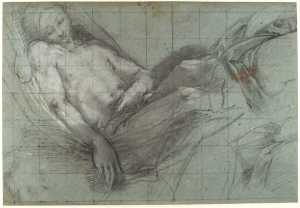Specifications
| Title | Study for 'The Entombment' |
|---|---|
| Material and technique | Black and white chalk, squared, on blue paper, laid down |
| Object type |
Drawing
> Two-dimensional object
> Art object
|
| Location | This object is in storage |
| Dimensions |
Width 373 mm Height 257 mm |
|---|---|
| Artists |
Draughtsman:
Barocci (Federico Fiori)
|
| Accession number | I 428 (PK) |
| Credits | Loan Stichting Museum Boijmans Van Beuningen (former Koenigs collection), 1940 |
| Department | Drawings & Prints |
| Acquisition date | 1940 |
| Creation date | in circa 1579-1582 |
| Watermark | None; indistinct watermark, possibly a crown, in the backing paper (between P3-4, below the centre, vH) |
| Inscriptions | '127' (verso, framed, below right, pencil), '52' (idem, above centre, pencil) |
| Collector | Collector / Franz Koenigs |
| Mark | F.W. Koenigs (L.1023a) on mount |
| Provenance | Art dealer Julius W. Böhler (1883-1966), Lucerne; Franz W. Koenigs (1881-1941, L.1023a), Haarlem, acquired in 1929; D.G. van Beuningen (1877-1955), Rotterdam, acquired with the Koenigs Collection in 1940 and donated to Stichting Museum Boijmans Van Beuningen |
| Exhibitions | Rotterdam 1938-39, no. 35; Groningen 1949, no. 13; Paris/Rotterdam/Haarlem 1962, no. 129; Bologna 1975, no. 108; Rotterdam/New York 1990, no. 69; Moscow 1995-96, no. 2; Florence 2000, no. 8; Rotterdam 2009 (coll 2 kw 1) |
| Internal exhibitions |
Italiaanse tekeningen in Nederlands bezit (1962) Van Pisanello tot Cézanne (1992) De Collectie Twee - wissel I, Prenten & Tekeningen (2009) |
| Research |
Show research Italian Drawings 1400-1600 |
| Literature | Voss 1928, no. 18, ill; Rotterdam 1938-39, no. 35; Groningen 1949, no. 13; Olsen 1955, pp. 10, 132, 134; Olsen 1962, p. 172; Jaffé 1962, p. 232; Paris/Rotterdam/Haarlem 1962, no. 129, ill. 97; Florence 1975, p. 52; Bologna 1975, no. 108; Pillsbury/Richards 1978, p. 65; De Grazia 1985, p. 40 n. 12; Emiliani 1985, p. 156, fig. 302; Luijten/Meij 1990, no. 69, ill.; Moskow 1995-96, no. 2, ill., pl. on p. 19; Florence 2000, no. 8, ill.; Luijten 2003, p. 21, fig. 41; Marciari/Verstegen 2008, pp. 304-05, 321, fig. 11c |
| Material | |
| Object | |
| Geographical origin | Italy > Southern Europe > Europe |
Do you have corrections or additional information about this work? Please, send us a message


























